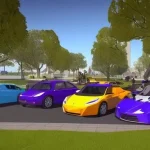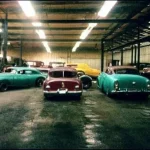In the relentless pursuit of speed‚ power‚ and unparalleled performance‚ engineers and automotive enthusiasts have often dared to dream beyond conventional limits. While the roar of a single‚ meticulously tuned engine is a symphony to many‚ imagine a cacophony of twin powerplants‚ working in concert to unleash an almost unfathomable force. This isn’t merely the stuff of science fiction or fantastical garage projects; the concept of a car with 2 engines is a tangible‚ albeit rare‚ reality‚ pushing the very boundaries of what’s mechanically possible and emotionally exhilarating. It represents a bold leap‚ driven by an insatiable quest for ultimate dominion over the asphalt.
From the drag strips where milliseconds dictate victory to custom builds where engineering prowess becomes a flamboyant art form‚ multi-engine vehicles stand as monuments to human ingenuity. These audacious machines challenge every preconceived notion of automotive design‚ demanding ingenious solutions for everything from power delivery and chassis integrity to cooling and weight distribution. Each twin-engine creation is a testament to vision‚ an intricate dance between raw horsepower and precision engineering‚ promising a future where automotive capabilities are continually stretched beyond their perceived breaking points. It’s a journey into the extraordinary‚ where more cylinders mean more stories‚ and every revolution of the crankshaft echoes the spirit of innovation.
| Feature Category | Description & Significance of Multi-Engine Vehicles |
|---|---|
| Core Concept | Utilizing two independent or synchronized powerplants (engines) within a single vehicle chassis to achieve exceptional performance‚ redundancy‚ or specialized functions. This often involves intricate mechanical and electronic integration. |
| Primary Motivations |
|
| Engineering Challenges |
|
| Notable Examples & Applications |
|
| Future Implications | While literal twin-combustion engines remain niche‚ the spirit of multi-powerplant integration is echoed in advanced hybrid and electric vehicle technologies‚ where multiple electric motors or a combination of electric and combustion engines work together for optimized performance and efficiency. This pushes the envelope for next-generation mobility. |
The engineering marvel behind a dual-engine behemoth is a symphony of coordinated chaos. Consider the meticulous calibration required to harmonize two distinct power units. It’s not simply about bolting in an extra engine; it’s about seamlessly integrating their power delivery‚ often through complex transfer cases or bespoke transmissions‚ ensuring that every horsepower is effectively channeled to the wheels without tearing the vehicle apart. As Dr. Evelyn Reed‚ a renowned automotive dynamics expert‚ eloquently puts it‚ “Building a multi-engine car is akin to conducting an orchestra where each section is a V8‚ and the conductor must ensure perfect timing and crescendo‚ or the entire performance collapses into discord.” This analogy perfectly captures the delicate balance between raw power and intricate control that such a project demands.
Beyond the sheer mechanical complexity‚ the performance gains are often staggering. Imagine the visceral sensation of a combined 1‚000‚ 2‚000‚ or even more horsepower propelling you forward. These aren’t just numbers on a spec sheet; they translate into a breathtaking acceleration that pins you to your seat and top speeds that blur the landscape into an impressionistic streak. Moreover‚ the distinctive rumble emanating from a dual exhaust system‚ each pipe connected to its own roaring heart‚ creates an auditory experience that is utterly unique and undeniably intoxicating. It’s a sensory overload that few conventional vehicles‚ regardless of their prestige‚ can replicate‚ making every drive an unforgettable event.
Historically‚ the allure of dual engines has captivated innovators for decades. From the legendary “Twin Mill” hot rod‚ boasting two supercharged V8s‚ which became an icon of custom car culture‚ to the more obscure experimental vehicles pushing the limits of speed and endurance‚ these machines have consistently challenged the status quo. These builds‚ often seen on shows like “Counting Cars‚” aren’t just about extravagance; they’re laboratories on wheels‚ testing the boundaries of torque management‚ structural integrity‚ and thermal dynamics in ways that often inform mainstream automotive advancements. By embracing such extreme designs‚ these pioneers inadvertently pave the way for future innovations‚ including sophisticated hybrid powertrains with multiple electric motors working in concert with a traditional engine.
Looking forward‚ the spirit of the car with 2 engines is evolving. While literal twin internal combustion engines might remain a niche for custom builders and drag racing aficionados‚ the underlying principle of combining multiple power sources for superior performance and efficiency is now a cornerstone of modern automotive design. Electric vehicles‚ for instance‚ frequently utilize two or even four electric motors‚ effectively acting as “multiple engines” to provide all-wheel drive‚ vectoring torque‚ and instantaneous power delivery far exceeding what a single motor could achieve. This forward-looking perspective suggests that the audacious vision of yesterday’s customizers is becoming the sophisticated reality of tomorrow’s mass-produced vehicles‚ driving us towards an incredibly exciting and powerful future.






